check engine SUZUKI JIMNY 2020 Owner's Guide
[x] Cancel search | Manufacturer: SUZUKI, Model Year: 2020, Model line: JIMNY, Model: SUZUKI JIMNY 2020Pages: 421, PDF Size: 6.35 MB
Page 229 of 421
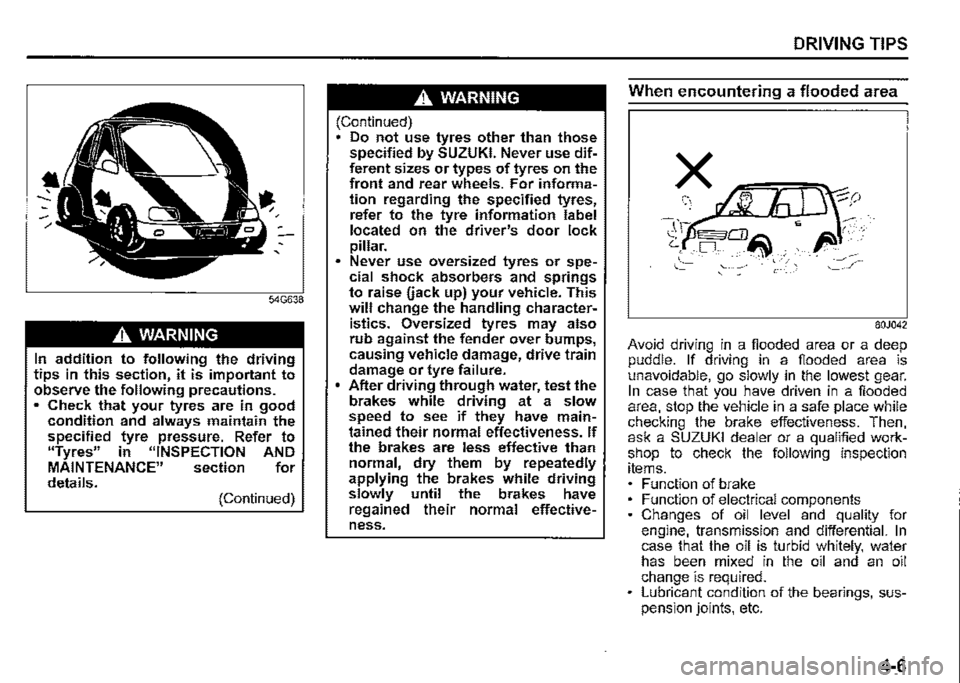
A WARNING
In addition to following the driving tips in this section, it is important to observe the following precautions. • Check that your tyres are in good condition and always maintain the specified tyre pressure. Refer to "Tyres" in "INSPECTION AND MAINTENANCE" section for details. (Continued)
A WARNING
(Continued) Do not use tyres other than those specified by SUZUKI. Never use different sizes or types of tyres on the front and rear wheels. For information regarding the specified tyres, refer to the tyre information label located on the driver's door lock pillar. Never use oversized tyres or spe~ cial shock absorbers and springs to raise uack up) your vehicle. This will change the handling characteristics. Oversized tyres may also rub against the fender over bumps, causing vehicle damage, drive train damage or tyre failure. After driving through water, test the brakes while driving at a slow speed to see if they have maintained their normal effectiveness. If the brakes are less effective than normal, dry them by repeatedly applying the brakes while driving slowly until the brakes have regained their normal effectiveness.
DRIVING TIPS
When encountering a flooded area
80J042
Avoid driving in a flooded area or a deep puddle. If driving in a flooded area is unavoidable, go slowly in the lowest gear. In case that you have driven in a flooded area, stop the vehicle in a safe place while checking the brake effectiveness. Then, ask a SUZUKI dealer or a qualified workshop to check the following inspection items. Function of brake Function of electrical components Changes of oil level and quality for engine, transmission and differential. In case that the oil is turbid whitely, water has been mixed in the oil and an oil change is required. Lubricant condition of the bearings, suspension joints, etc.
4-6
Page 230 of 421
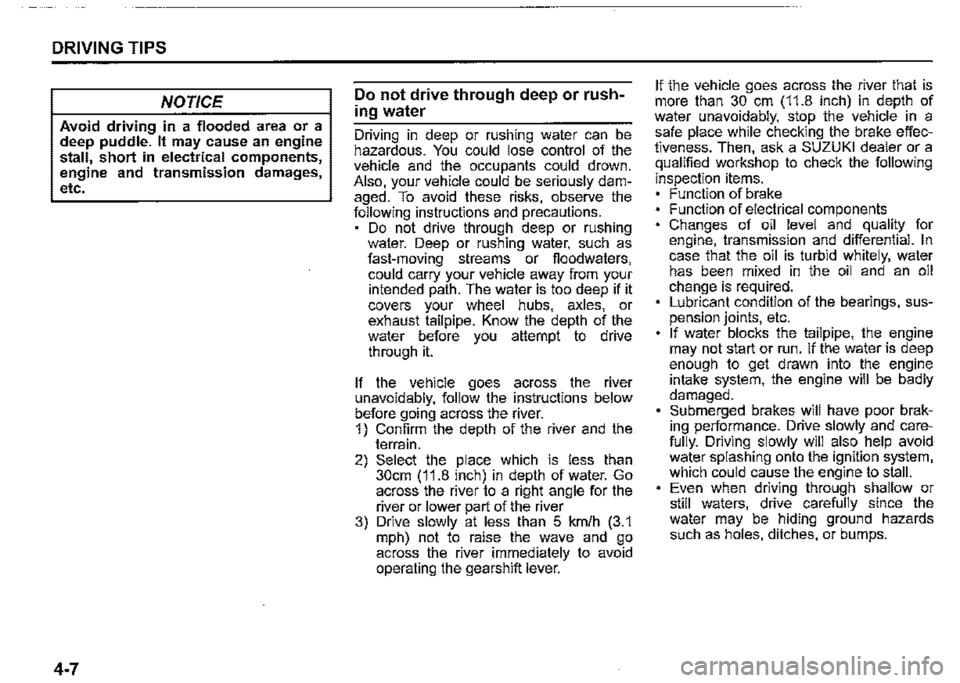
DRIVING TIPS
NOTICE
Avoid driving in a flooded area or a deep puddle. It may cause an engine stall, short in electrical components, engine and transmission damages, etc.
4-7
Do not drive through deep or rush
ing water
Driving in deep or rushing water can be hazardous. You could lose control of the vehicle and the occupants could drown. Also, your vehicle could be seriously damaged. To avoid these risks, observe the following instructions and precautions. Do not drive through deep or rushing water. Deep or rushing water, such as fast-moving streams or fioodwaters, could carry your vehicle away from your intended path. The water is too deep if it covers your wheel hubs, axles, or exhaust tailpipe. Know the depth of the water before you attempt to drive through it.
If the vehicle goes across the river unavoidably, follow the instructions below before going across the river. 1) Confirm the depth of the river and the terrain. 2) Select the place which is less than 30cm (11.8 inch) in depth of water. Go across the river to a right angle for the river or lower part of the river 3) Drive slowly at less than 5 km/h (3.1 mph) not to raise the wave and go across the river immediately to avoid operating the gearshift lever.
If the vehicle goes across the river that is more than 30 cm (11.8 inch) in depth of water unavoidably, stop the vehicle in a safe place while checking the brake effectiveness. Then, ask a SUZUKI dealer or a qualified workshop to check the following
inspection items. Function of brake Function of electrical components Changes of oil level and quality for engine, transmission and differential. In case that the oil is turbid whitely, water has been mixed in the oil and an oil change is required. Lubricant condition of the bearings, suspension joints, etc. If water blocks the tailpipe, the engine may not start or run. If the water is deep enough to get drawn into the engine intake system, the engine will be badly damaged. Submerged brakes will have poor braking performance. Drive slowly and carefully. Driving slowly will also help avoid water splashing onto the ignition system, which could cause the engine to stall. Even when driving through shallow or still waters, drive carefully since the water may be hiding ground hazards such as holes, ditches, or bumps.
Page 236 of 421
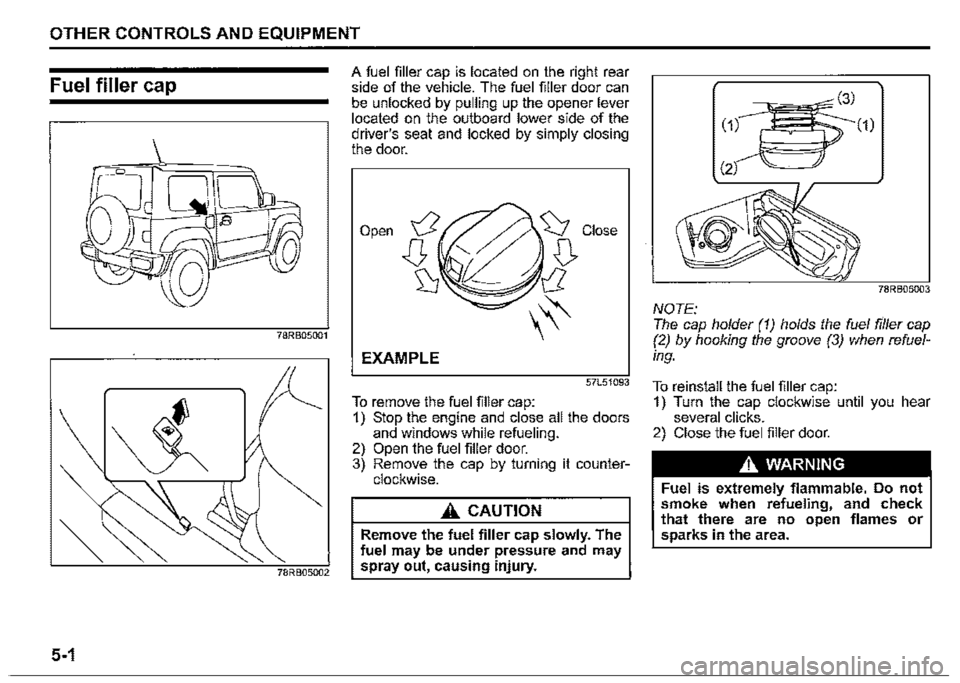
OTHER CONTROLS AND EQUIPMENT
Fuel filler cap
78RB05001
5-1
A fuel filler cap is located on the right rear side of the vehicle. The fuel filler door can be unlocked by pulling up the opener lever located on the outboard lower side of the driver's seat and locked by simply closing the door.
Open
EXAMPLE
57L51093
To remove the fuel filler cap: 1) Stop the engine and close all the doors and windows while refueling. 2) Open the fuel filler door. 3) Remove the cap by turning it counterclockwise.
A CAUTION
Remove the fuel filler cap slowly. The fuel may be under pressure and may spray out, causing injury.
78RB05003
NOTE: The cap holder (1) holds the fuel filler cap (2) by hooking the groove (3) when refuel
ing.
To reinstall the fuel filler cap: 1) Turn the cap clockwise until you hear several clicks. 2) Close the fuel filler door.
A WARNING
Fuel is extremely flammable. Do not smoke when refueling, and check that there are no open flames or sparks in the area.
Page 237 of 421
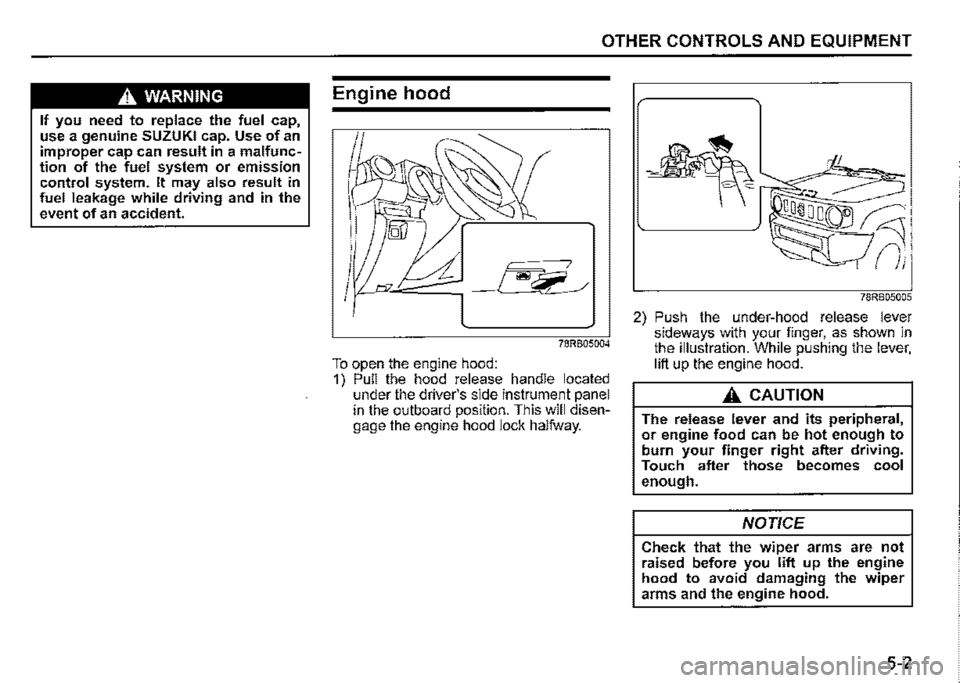
A WARNING
If you need to replace the fuel cap, use a genuine SUZUKI cap. Use of an improper cap can result in a malfunction of the fuel system or emission control system. It may also result in fuel leakage while driving and in the event of an accident.
OTHER CONTROLS AND EQUIPMENT
Engine hood
78RB05004
To open the engine hood: 1) Pull the hood release handle located under the driver's side instrument panel in the outboard position. This will disengage the engine hood lock halfway.
78RB05005
2) Push the under-hood release lever sideways with your finger, as shown in the illustration. While pushing the lever, lift up the engine hood.
A CAUTION
The release lever and its peripheral, or engine food can be hot enough to burn your finger right after driving. Touch after those becomes cool enough.
NOTICE
Check that the wiper arms are not raised before you lift up the engine hood to avoid damaging the wiper arms and the engine hood.
5-2
Page 238 of 421

OTHER CONTROLS AND EQUIPMENT
78RB05006
3) While holding the hood, pull the prop rod out from the holding clip, and then insert the end of the rod into the designated hole.
A CAUTION
• The prop rod can be hot enough to burn your finger right after driving. Touch the rod after it becomes cool enough. Insert the end of the rod into the hole securely. If the rod slips out, you may get caught in the closing hood. • The rod may slip out when the hood is blown by wind. Be careful on windy days.
5-3
To close the engine hood: 1) Lift the hood up slightly and remove the prop rod from the hole. Put the prop rod back into the holding clip.
78RB05007
2) Lower the hood to about 20 cm above the hood latch, and then let it drop down. Check that the hood is securely latched after closing.
A WARNING
Check that the hood is fully closed and latched before driving. If it is not, it can fly up unexpectedly during driving, obstructing your view and resulting in an accident.
A CAUTION
To avoid injury, check that no part of the occupant's body such as hands or head is in the path of the hood when closing it.
NOTICE
Pushing on the hood from the top may damage it.
Page 318 of 421
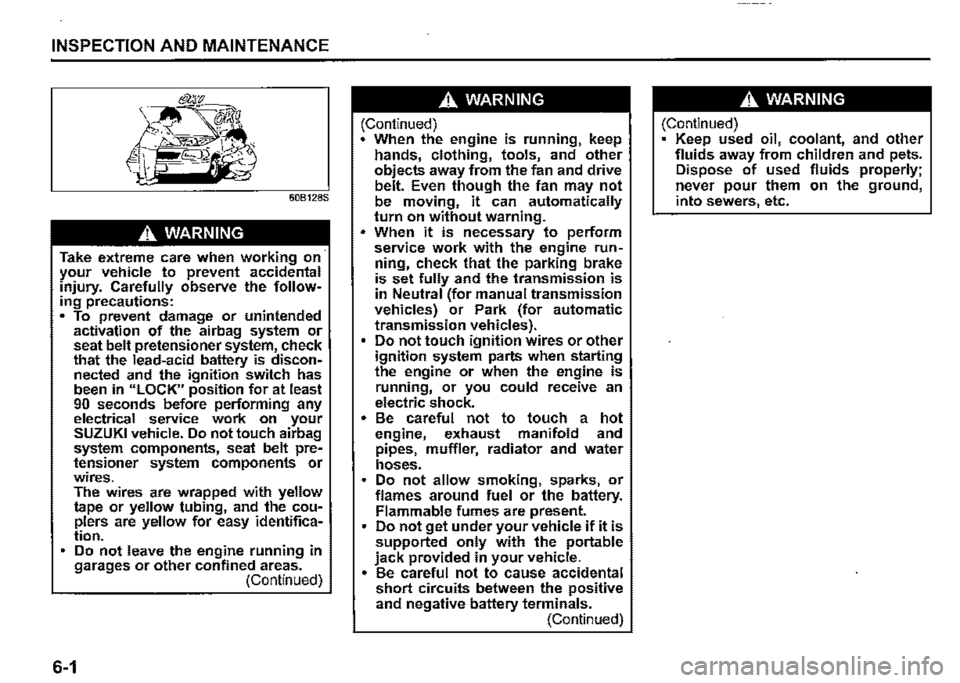
INSPECTION AND MAINTENANCE
60B128S
.A. WARNING
Take extreme care when working on· your vehicle to prevent accidental injury. Carefully observe the following precautions: • To prevent damage or unintended activation of the airbag system or seat belt pretensioner system, check that the lead-acid battery is disconnected and the ignition switch has been in "LOCK" position for at least 90 seconds before performing any electrical service work on your SUZUKI vehicle. Do not touch airbag system components, seat belt pretensioner system components or wires. The wires are wrapped with yellow tape or yellow tubing, and the couplers are yellow for easy identification. Do not leave the engine running in garages or other confined areas. (Continued)
6-1
.A. WARNING
(Continued) When the engine is running, keep hands, clothing, tools, and other objects away from the fan and drive belt. Even though the fan may not be moving, it can automatically turn on without warning . • When it is necessary to perform service work with the engine run~ ning, check that the parking brake is set fully and the transmission is in Neutral (for manual transmission vehicles) or Park (for automatic transmission vehicles). Do not touch ignition wires or other ignition system parts when starting the engine or when the engine is running, or you could receive an electric shock. • Be careful not to touch a hot engine, exhaust manifold and pipes, muffler, radiator and water hoses. Do not allow smoking, sparks, or flames around fuel or the battery. Flammable fumes are present. Do not get under your vehicle if it is supported only with the portable jack provided in your vehicle. • Be careful not to cause accidental short circuits between the positive and negative battery terminals. (Continued)
.A. WARNING
(Continued) Keep used oil, coolant, and other fluids away from children and pets. Dispose of used fluids properly; never pour them on the ground, into sewers, etc.
Page 321 of 421
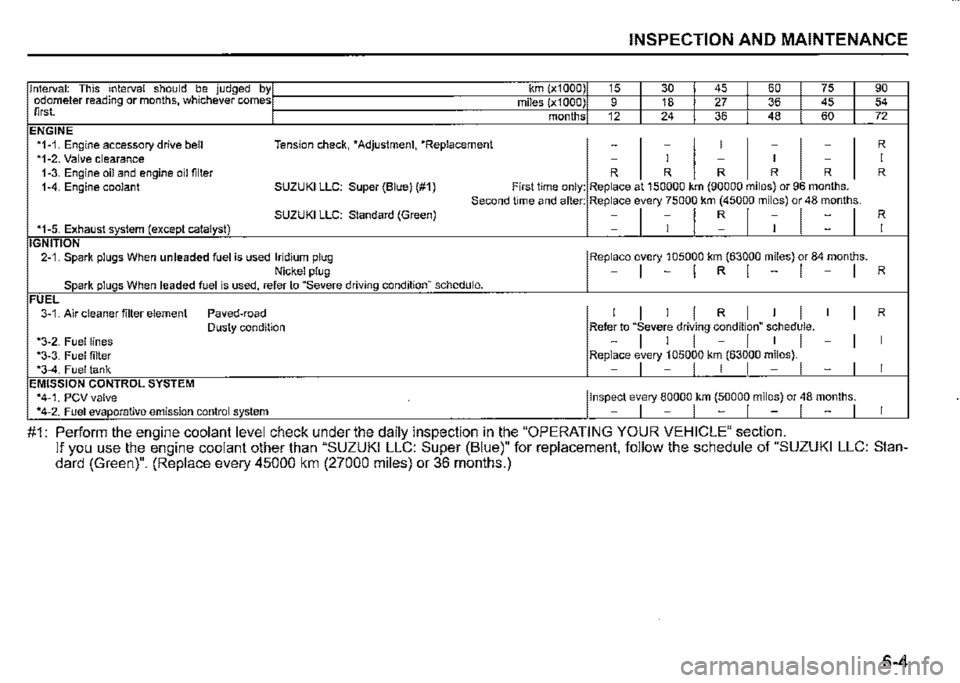
INSPECTION AND MAINTENANCE
Interval: This interval should be judged by1 km (x1000) 15 I 30 I 45 I 60 I 75 I 90 odometer reading or months, whichever comesI miles (x1000) 9 I 18 I 27 I 36 I 45 I 54 first. 1 months 12 I 24 I 36 I 48 I 60 I 72 ENGINE *1-1. Engine accessory drive bell Tension check, *Adjustment, *Replacement -
I
-
I
I
I
-
I
-
I
R *1-2. Valve clearance -I -I -I 1-3. Engine oil and engine oil filter R R R R R R 1-4. Engine coolant SUZUKI LLC: Super (Blue) (#1) First time only: Replace at 150000 km (90000 miles) or 96 months. Second time and after: Replace every 75000 km (45000 miles) or 48 months. SUZUKI LLC: Standard (Green) =l1l~l1l=I R *1-5. Exhaust system (except catalyst) I IGNITION 2-1. Spark plugs When unleaded fuel is used Iridium plug I Replace every 105000 km (63000 miles) or 84 months. Nickel plug -I-IRl-1-1 R Spark plugs When leaded fuel is used, refer to "Severe driving conditionn schedule. FUEL 3-1. Air cleaner filter element Paved-road I I I I R I I I I I R Dusty condition Refer to "Severe driving condition" schedule. *3-2. Fuel lines -I I I -I I I -I I *3-3. Fuel filter Replace every 105000 km (63000 miles). *3-4. Fuel tank -I -I I I -I -I I EMISSION CONTROL SYSTEM *4-1. PCV valve I Inspect every 80000 km (50000 miles) or 48 months. *4-2. Fuel evaporative emission control system -1-1-1-1-1 I
#1: Perform the engine coolant level check under the daily inspection in the "OPERATING YOUR VEHICLE" section. If you use the engine coolant other than "SUZUKI LLC: Super (Blue)" for replacement, follow the schedule of "SUZUKI LLC: Standard (Green)". (Replace every 45000 km (27000 miles) or 36 months.)
6-4
Page 322 of 421
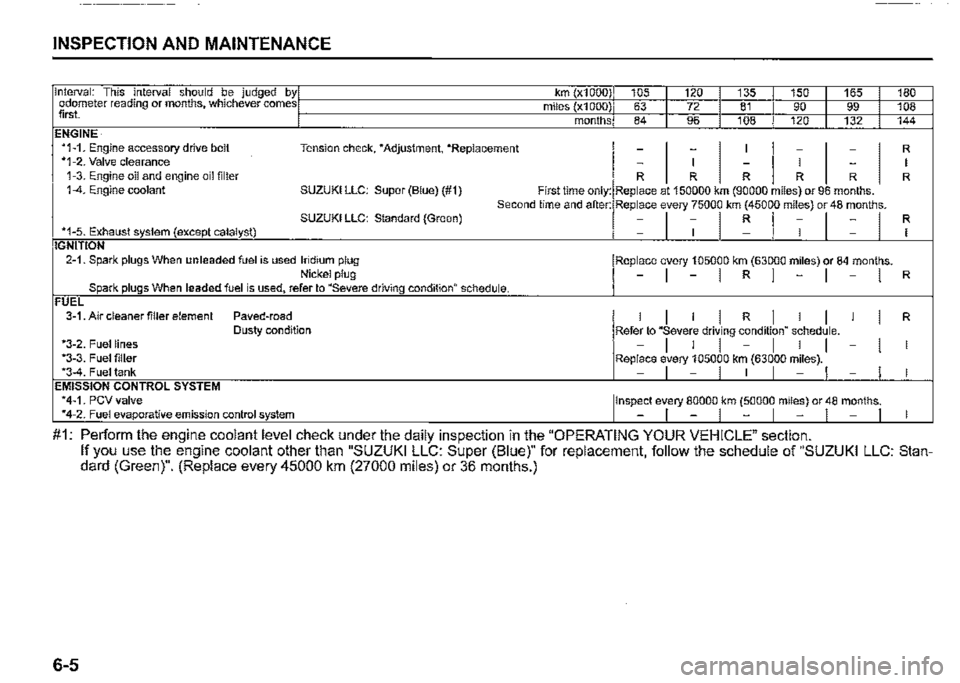
INSPECTION AND MAINTENANCE
Interval: This interval should be judged byl km (X1000) 105 I 120 I 135 I 150 I 165 I 180 odometer reading or months, whichever comesI miles (x1000) 63 I 72 I 81 I 90 I 99 I 108 first. I months 84 I 96 I 108 I 120 I 132 I 144 ENGINE *1-1. Engine accessory drive belt Tension check, • Adjustment, *Replacement -
I
-
I
I
I
-
I
-
I
R *1-2. Valve clearance -I -I -I 1-3. Engine oil and engine oil filter R R R R R R 1-4. Engine coolant SUZUKI LLC: Super (Blue) (#1) First time only: Replace at 150000 km (90000 miles) or 96 months. Second time and after: Replace every 75000 km (45000 miles) or 48 months. SUZUKI LLC: Standard (Green) =l~l~l~l=I R *1-5. Exhaust system (except catalyst) I IGNITION 2-1. Spark plugs When unleaded fuel is used Iridium plug I Replace every 105000 km (63000 miles) or 84 monlhs. Nickel plug -I-IRl-1-1 R Spark plugs When leaded fuel is used, refer to "Severe driving condition" schedule. FUEL 3-1. Air cleaner filter element Paved-road I I I I R I I I I I R Dusty condition Refer to MSevere driving condition" schedule. *3-2. Fuel lines -I I I -I I I -I I *3-3. Fuel filter Replace every 105000 km (63000 miles). *3-4. Fuel tank -I -I I I -I -I I EMISSION CONTROL SYSTEM *4-1. PCVvalve I Inspect every 80000 km (50000 miles) or 48 months. '"4-2. Fuel evaporative emission control system -I -I -I -I -I I
#1: Perform the engine coolant level check under the daily inspection in the "OPERATING YOUR VEHICLE" section. If you use the engine coolant other than "SUZUKI LLC: Super (Blue)" for replacement, follow the schedule of "SUZUKI LLC: Standard (Green)". (Replace every 45000 km (27000 miles) or 36 months.)
6-5
Page 326 of 421
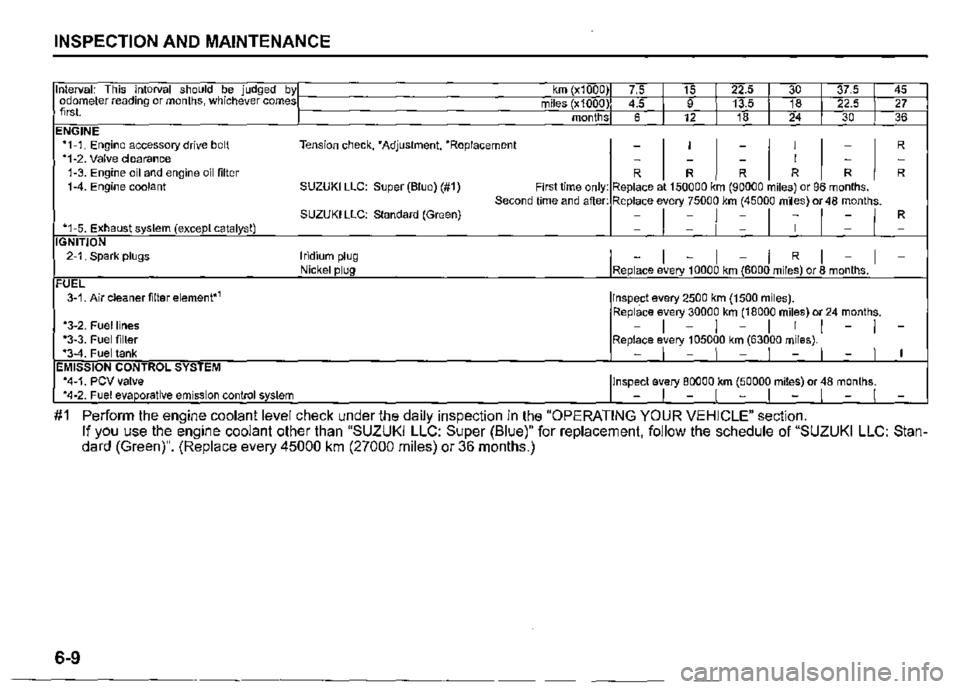
INSPECTION AND MAINTENANCE
Interval: This interval should be judged byl km (x1000) 7.5 I 15 I 22.5 I 30 I 37.5 I 45 odometer reading or months, whichever comesI miles (x1000) 4.5 I 9 I 13.5 I 18 I 22.5 I 27 first. I months 6 I 12 I 18 I 24 I 30 I 36 ENGINE *1-1. Engine accessory drive belt Tension check, *Adjustment, *Replacement -
I
I
I
-
I
I
I
-
I
R *1-2. Valve clearance ---I --1-3. Engine oil and engine oil filter R R R R R R 1-4. Engine coolant SUZUKI LLC: Super (Blue) (#1) First time only: Replace at 150000 km (90000 miles) or 96 months. Second time and after: Replace every 75000 km (45000 m·1res) or48 months. SUZUKI LLC: Standard (Green)
= I = I = I ~ I = I
R *1-5. Exhaust system (except catalyst) -IGNITION 2-1 . Spark plugs Iridium plug 1-1-I-IRI-I -Nickel plug Replace every 10000 km (6000 miles) or 8 months. FUEL 3-1. Air cleaner filter element•1 lnspe_ct every 2500 km (1500 miles). Replace every 30000 km (18000 miles) or 24 months. *3-2. Fuel lines -I -I -I I I -I -*3-3. Fuel filter Replace every 105000 km (63000 miles). *3-4. Fuel tank -I -I -I -I -I I EMISSION CONTROL SYSTEM *4-1. PCV valve llnspecl every 80000 km (50000 miles) or 48 months. *4-2. Fuel evaporative emission control system -1-1-1-1-1 -
#1 Perform the engine coolant level check under the daily inspection in the "OPERATING YOUR VEHICLE" section. If you use the engine coolant other than "SUZUKI LLC: Super (Blue)" for replacement, follow the schedule of "SUZUKI LLC: Standard (Green)". (Replace every 45000 km (27000 miles) or 36 months.)
6-9
Page 327 of 421
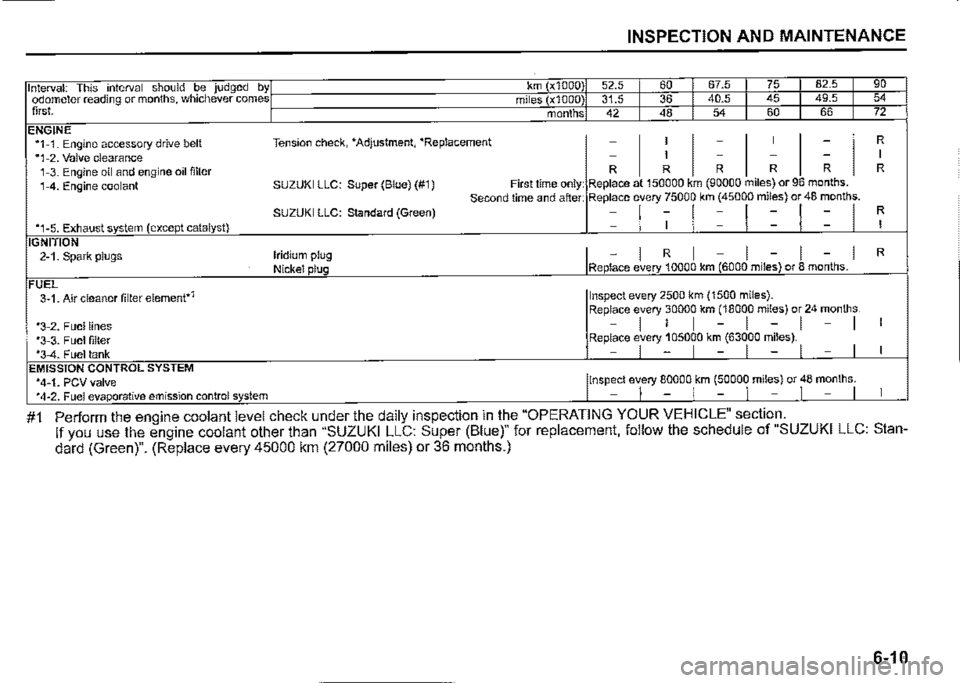
INSPECTION AND MAINTENANCE
Interval: This interval should be judged byl km (x1000) 52.5 I 60 I 67.5 I 75 82.5 I 90 odometer reading or months, whichever comesI miles (x1000) 31.5 I 36 I 40.5 I 45 49.5 I 54 first. I months 42 I 48 I 54 I 60 I 66 I 72
ENGINE *1-1. Engine accessory drive belt Tension check, *Adjustment, *Replacement -
I
I
I
-
I
I
I
-
I
R
"1-2. Valve clearance -I ---I
1-3. Engine oil and engine oil filter R R R R R R
1-4. Engine coolant SUZUKI LLC: Super (Blue) (#1) First time only: Replace at 150000 km (90000 miles) or 96 months. Second time and after: Replace every 75000 km (45000 miles) o! 48 months. SUZUKI LLC: standard {Green) -1~1-1= -1 R
*1-5. Exhaust system (except catalyst) I
IGNITION 2-1. Spark plugs Iridium plug I, -I R I -I -I -I R
Nickel plug Replace every 10000 km (6000 miles) or 8 months.
FUEL 3-1. Air cleaner filter element*1 Inspect every 2500 km (1500 miles).
*3-2. Fuel lines
Replace every 30000 km (18000 miles) or 24 months.
I -I I I -I -I -I
*3-3. Fuel filter Rep~ce etry 2oso~o k~ (63oIoo m~es).I *3-4. Fuel tank -I I
EMISSION CONTROL SYSTEM *4-1. PCV valve 1Insp~ct e\ery a~oooIkm (:ooo~ mile~) or fB m~nthsj *4-2. Fuel evaporative emission control system I
#1 Perform the engine coolant level check under the daily inspection in the "OPERATING YOUR VEHICLE" section. If you use the engine coolant other than "SUZUKI LLC: Super (Blue)" for replacement, follow the schedule of "SUZUKI LLC: Stan
dard (Green)". (Replace every 45000 km (27000 miles) or 36 months.)
6-10